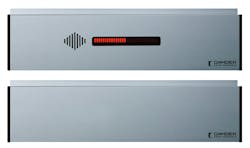Unlike other locks within a building, no access control product is scrutinized more than delayed egress locking systems, from mandatory International Building Code (IBC), International Fire Code (IFC), and National Fire Protection Association (NFPA) codes and regulations, to additional local requirements based on the type of facility, to proper integration with a building’s fire alarm systems.
Because there is so much to consider prior to installation, “it is essential to do all the pre-installation investigation to ensure all the requirements are met by the authority having jurisdiction (AHJ) and the functionality meets the property manager expectations,” says David Ito, technical services manager, Camden Door Controls, who took some time to sit down with Locksmith Ledger for a deep dive into the latest delayed egress techniques and installation requirements.
Locksmith Ledger: Please talk about the key considerations and approaches regarding “techniques & installations for delayed egress” today and how they may differ from what was done in the past?
Ito: Delayed egress systems are subject to regulation, making compliance with the (IBC and local fire safety regulations mandatory. Prior to installation, approval must be obtained from the authority having jurisdiction (AHJ) which include the local authorities, fire marshal and building inspector. While this requirement has not changed, property managers cannot legally install a delayed egress lock without prior authorization.
The lock's operation type must be specified in advance, as certain features, such as the 15- or 30-second delayed release time, cannot be adjusted in the field and must be configured at the factory on some types while other operation types allow in-the-field selection. The lock manufacturer will list the various operation types to order for your specific installation.
Delayed Egress systems must be integrated with the fire alarm system and testing with the fire alarm system will be required.
LL: Because code considerations are vitally important for proper, code-compliant delayed egress installation, can you outline some important considerations and starting points in delayed egress, especially with so many codes and standards in this ?
Ito: Due to the various codes for delayed egress, the best approach is to consult with the AHJs before beginning the installation process. There are specific applications addressed in the IBC such as having no more than two delayed egress locks for an egress path and with a combined delay not to exceed 30 seconds. Camden provides a lock for double-door applications where some manufacturers only have locks for single-door applications. For double-door applications (CX-DE1220), two locks are provided for each door, one being the main lock and the other the tandem lock.Lock manufacturers may provide the mandatory door signage but, some jurisdictions enforce Braille signage. Braille signs for delayed egress doors that are compliant to ADA and IBC are available (Camden Part 60-57A027).
LL: Delayed-egress requirements can change according to the code cycle and application (schools, hospitals, etc.). Have there been any recent ones of note, or ones that have not been mentioned in the last question?
Ito: The 3-second "nuisance delay period" for delayed egress locks was introduced to prevent accidental activation of the locking system when someone unintentionally touches or lightly presses on the egress door. This period allows individuals to retract their action before initiating the full egress delay sequence.
The IBC 2015 Edition and the NFPA 101 2015 Edition Life Safety Code both introduced the 3-second nuisance delay as part of the regulatory standards for delayed egress locks.
The nuisance delay was included to enhance security while preventing accidental activations of the delay timer. After the 3-second continuous pressure on the door hardware, the 15- or 30-second delay period begins, during which the door will release after the delay expires, ensuring controlled egress.
This feature is particularly important in settings where delayed egress locks are used to balance security with emergency egress requirements, such as in healthcare facilities, retail stores, and correctional institutions.
LL: Please talk about any new trends or innovations on the product side regarding delayed egress, and/or any products growing in interest and demand?
Ito: Delayed egress locks are subject to various codes and standards, but some innovation is being done by lock manufacturers for annunciation including voice messages versus an alarm tone.
Camden delayed egress locks provide a regressive LED segment bar to visually show the 15- or 30-second countdown before the door releases. The same lock has a DIP switch to change the alarm buzzer tone to a voice message, “Door will unlock in 30…20…10… seconds, door unlocked, door unlock …” Some property managers prefer a voice message to distinguish it from other alarm devices on site.
LL: Building on the last question, what role does electronic access control have on the installation and management of delayed egress doors/systems?
Ito: Access control provides enhanced security and control by offering centralized management and enhanced integration.
Centralized management allows for centralized monitoring and control of numerous delayed egress locks. Security personnel monitor the status of doors, receive alerts when the delayed egress lock goes into alarm and remotely unlock doors when necessary, offering a higher level of efficiency.
Integration with alarm systems from the access control seamlessly integrates to other building management systems and routing the alarm condition to specific departments or individuals.
Scheduling from an access control system can impose specific time-based restrictions on delayed egress doors, allowing free egress during certain hours while activating delayed egress during off-hours for increased security.
Electronic access control systems create detailed audit trails, documenting each interaction with a delayed egress door, such as when it was activated, released, or overridden. These logs are useful for compliance reporting and for AHJs during inspections.
LL: Are there some other areas that we have not covered regarding techniques and installations of delayed egress that you would like to address?
Ito: Consider all necessary peripherals to ensure a complete solution. Devices that can be mounted to standard single-gang switch boxes should include a remote annunciator for both audible and visual alerts, as well as a remote key switch reset station. Camden's CX-DE502SO and CX-DESPK models fulfill these roles, respectively. For enhanced audio coverage, the CX-DESPK15 model, a 15-watt remote speaker station with an optional RGB LED, ensures that alarms are both clearly heard and visibly recognized from any location
LL: Where are we headed in the next five years in this space, either product wise or regarding installation techniques or standards/codes?
Ito: Currently there is no standard indicating the dB alarm sound level which should be added. Camden locks are loud, providing voice messages at over 85 dB.
IBC Code for Delayed Egress Locking System
The delayed egress locking system shall be installed and operated in accordance with all of the following:
· The delay electronics of the delayed egress locking system shall deactivate upon actuation of the automatic sprinkler system or automatic fire detection system, allowing immediate free egress.
· The delay electronics of the delayed egress locking system shall deactivate upon loss of power controlling the lock or lock mechanism, allowing immediate free egress.
· The delayed egress locking system shall have the capability of being deactivated at the fire command center and other approved locations.
· An attempt to egress shall initiate an irreversible process that shall allow such egress in not more than 15 seconds when a physical effort to exit is applied to the egress side door hardware for not more than 3 seconds. Initiation of the irreversible process shall activate an audible signal in the vicinity of the door. Once the delay electronics have been deactivated, rearming the delay electronics shall be by manual means only.
· Exception: Where approved, a delay of not more than 30 seconds is permitted on a delayed egress door.
· The egress path from any point shall not pass through more than one delayed egress locking system.
The following are exceptions:
· In Group I-2 or I-3 occupancies, the egress path from any point in the building shall pass through not more than two delayed egress locking systems provided that the combined delay does not exceed 30 seconds.
· In Group I-1 or I-4 occupancies, the egress path from any point in the building shall pass through not more than two delayed egress locking systems provided the combined delay does not exceed 30 seconds and the building is equipped throughout with an automatic sprinkler system in accordance with Section 903.3.1.1.
· A sign shall be provided on the door and shall be located above and within 12 inches (305 mm) of the door exit hardware:
· For doors that swing in the direction of egress, the sign shall read: PUSH UNTIL ALARM SOUNDS. DOOR CAN BE OPENED IN 15 [30] SECONDS.
· For doors that swing in the opposite direction of egress, the sign shall read: PULL UNTIL ALARM SOUNDS. DOOR CAN BE OPENED IN 15 [30] SECONDS.
· The sign shall comply with the visual character requirements in ICC A117.1. Exception: Where approved, in Group I occupancies, the installation of a sign is not required where care recipients who because of clinical needs require restraint or containment as part of the function of the treatment area.
· Emergency lighting shall be provided on the egress side of the door.
· The delayed egress locking system units shall be listed in accordance with UL 294.
About the Author
Paul Ragusa
Senior Editor
Paul Ragusa is senior editor for Locksmith Ledger. He has worked as an editor in the security industry for nearly 10 years. He can be reached at [email protected].



